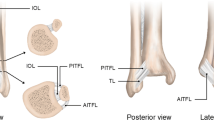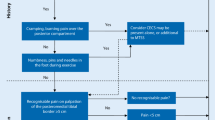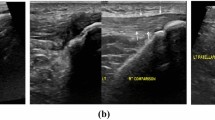Abstract
Background
Selective neurotomy is known as an effective method to reduce focal spasticity when medical treatment including botulinum toxin is not sufficient. The tibial nerve can be targeted to treat spastic equinovarus foot with (or without) claw toes.
Method
Tibial nerve trunk is dissected in the popliteal fossa. Sensitive and motor branches are identified using electrical stimulation to monitor motor responses. The muscular nerves corresponding to the targeted muscles are partially sectioned according to a preoperative chart. A postoperative rehabilitation program is mandatory.
Conclusion
Precise and rigorous selective neurotomy provided a definitive and safe treatment for spastic equinovarus foot.
Similar content being viewed by others
References
Baroncini M, Baïz H, Wavreille G, Demondion X, Maurage CA, Buisset N, Blond S, Kim H-J, Fontaine C (2008) Anatomical bases of tibial neurotomy for treatment of spastic foot. Surg Radiol Anat 30(6):503–508
Bollens B, Gustin T, Stoquart G, Detrembleur C, Lejeune T, Deltombe T (2013) A randomized controlled trial of selective neurotomy versus botulinum toxin for spastic equinovarus foot after stroke. Neurorehabil Neural Repair 27(8):695–703
Buffenoir K, Roujeau T, Lapierre F, Menei P, Menegalli-Boggelli D, Mertens P, Decq P (2004) Spastic equinus foot: multicenter study of the long-term results of tibial neurotomy. Neurosurgery 55(5):1130–1137
Deltombe T, Gilliaux M, Peret F, Leeuwerck M, Wautier D, Hanson P, Gustin T (2018) Effect of the neuro-orthopedic surgery for spastic equinovarus foot after stroke: a prospective longitudinal study based on a goal-centered approach. Eur J Phys Rehabil Med 54(6):853–859
Gustafson KJ, Grinberg Y, Joseph S, Triolo RJ (2012) Human distal sciatic nerve fascicular anatomy: implications for ankle control using nerve-cuff electrodes. J Rehabil Res Dev 49(2):309–321
Le Bocq C, Rousseaux M, Buisset N, Daveluy W, Blond S, Allart E (2016) Effects of tibial nerve neurotomy on posture and gait in stroke patients: a focus on patient-perceived benefits in daily life. J Neurol Sci 366:158–163
Rousseaux M, Buisset N, Daveluy W, Kozlowski O, Blond S (2009) Long-term effect of tibial nerve neurotomy in stroke patients with lower limb spasticity. J Neurol Sci 278(1–2):71–76
Sindou M, Mertens P (1988) Selective neurotomy of the tibial nerve for treatment of the spastic foot. Neurosurgery 23(6):738–744
Sindou MP, Simon F, Mertens P, Decq P (2007) Selective peripheral neurotomy (SPN) for spasticity in childhood. Childs Nerv Syst 23(9):957–970
Zhong S, Li G, Yang L, Yan Q, Wang Y, Zhao G, Li Y (2017) Anatomic and ultrasonic study based on selective tibial neurotomy. World Neurosurg 99:214–225
Author information
Authors and Affiliations
Corresponding author
Ethics declarations
Conflict of interest
The authors declare that they have no conflict of interest.
Additional information
Key Points
• Detailed multidisciplinary clinical assessment with nerve block-test and/or toxin injection must be performed preoperatively in order to decide surgical indication but also to establish a preoperative chart determining muscles to be targeted and the proportion of sectioning for each nerve.
• Installation of the patient on the operating table must allow the surgeon to check the motor responses to stimulations.
• Precise electrical nerve stimulation is mandatory during surgery for nerve mapping. This allows the differentiation of sensitive from motor branches, and, after fascicles section, it allows to check the amount of residual motor response.
• Inside the tibial nerve trunk, it is necessary to be very careful and do not handle or cut sensitive fascicles with the risk of secondary neuropathic pain.
• Necessity of postoperative rehabilitation program to take in profit the new neurological status.
Publisher’s note
Springer Nature remains neutral with regard to jurisdictional claims in published maps and institutional affiliations.
This article is part of the Topical Collection on Functional Neurosurgery - Other
Electronic supplementary material
Selective tibial nerve neurotomy. (MP4 463348 kb)
Rights and permissions
About this article
Cite this article
Dauleac, C., Sindou, M. & Mertens, P. How I do it: selective tibial neurotomy. Acta Neurochir 162, 1921–1923 (2020). https://doi.org/10.1007/s00701-020-04314-9
Received:
Accepted:
Published:
Issue Date:
DOI: https://doi.org/10.1007/s00701-020-04314-9




